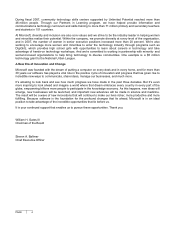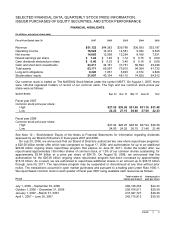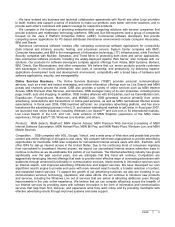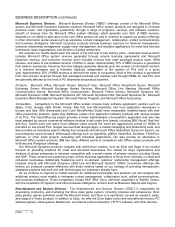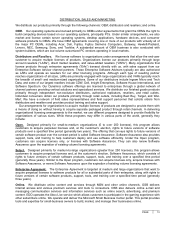Microsoft 2007 Annual Report Download - page 12
Download and view the complete annual report
Please find page 12 of the 2007 Microsoft annual report below. You can navigate through the pages in the report by either clicking on the pages listed below, or by using the keyword search tool below to find specific information within the annual report.
PAGE 11
EDD also leads the development efforts of our line of consumer software and hardware products including
application software for Macintosh computers and Microsoft PC hardware products, and is responsible for all retail
sales and marketing for Microsoft Office and the Windows operating systems. EDD also includes the mobile and
embedded devices platform and is responsible for managing our company-wide sales and customer relations with
device manufacturers and other communication-sector customers including network service providers and media
and entertainment companies.
Products. Xbox 360 console and games; Xbox Live; Zune; Mediaroom; numerous consumer software and
hardware products (such as mice and keyboards); Windows Mobile software platform; Windows Embedded
device operating system; and Windows Automotive.
Competition. Entertainment and devices businesses are highly competitive, characterized by rapid product life
cycles, frequent introductions of new products and titles, and the development of new technologies. The markets
for our products are characterized by significant price competition. We anticipate continued pricing pressure from
our competitors. From time to time, we have responded to this pressure by reducing prices on certain products.
Our competitors vary in size from very small companies with limited resources to very large, diversified
corporations with substantial financial and marketing resources. We compete primarily on the basis of product
innovation, quality and variety, timing of product releases, and effectiveness of distribution and marketing.
Our Xbox hardware business competes with console platforms from Nintendo and Sony, both of which have a
large, established base of customers. The lifecycle for video game consoles averages five to seven years. We
released Xbox 360, our second generation console, in November 2005. Nintendo and Sony released new
versions of their game consoles in late 2006. We believe the success of video game consoles is determined by
the availability of games for the console, providing exclusive game content that gamers seek, the computational
power and reliability of the console, and the ability to create new revenue sources such as advertising and
downloadable content. We think the Xbox 360 is positioned well against competitive console products based on
significant innovation in hardware architecture, new developer tools, expanded revenue sources, and continued
strong exclusive content from our own game franchises such as Halo.
In addition to competing against software published for non-Xbox platforms, our games business also
competes with numerous companies that we have licensed to develop and publish software for the Xbox
consoles. Zune competes with the Apple iPod as well as other digital music and entertainment devices. Our PC
hardware products face aggressive competition from computer and other hardware manufacturers, many of which
are also current or potential partners. Mediaroom faces competition primarily from a variety of competitors that
provide elements of an IPTV delivery platform, but that do not provide end-to-end solutions for the network
operator. Windows Mobile software faces substantial competition from Nokia, Openwave Systems, Palm,
QUALCOMM, Research In Motion, and Symbian. The embedded operating system business is highly fragmented
with many competitive offerings. Key competitors include IBM, Wind River, and versions of embeddable Linux
from commercial Linux vendors such as Metrowerks and MontaVista Software.
OPERATIONS
To serve the needs of customers around the world and to improve the quality and usability of products in
international markets, we “localize” many of our products to reflect local languages and conventions. Localizing a
product may require modifying the user interface, altering dialog boxes, and translating text.
Our operational centers support all operations in their regions, including customer contract and order
processing, credit and collections, information processing and vendor management and logistics. The regional
center in Ireland supports the European, Middle Eastern, and African region; the center in Singapore supports the
Japan, Greater China and Asia-Pacific region; and the centers in Fargo, Puerto Rico, Redmond, and Reno
support Latin America and North America.
We contract most of our manufacturing activities to third parties who produce the Xbox 360, Zune, various
retail software packaged products, and Microsoft hardware. Our products may include some components that are
available from only one or limited sources. Our Xbox 360 console includes certain key components that are
supplied by a single source. The central processing unit is purchased from IBM and the graphics chips and
embedded dynamic random access memory chips for the graphics processing unit are purchased from Taiwan
Semiconductor Manufacturing Company and NEC Corporation, respectively. Although we have chosen to initially
source these key Xbox 360 components from a single supplier, we are under no obligation to exclusively source





